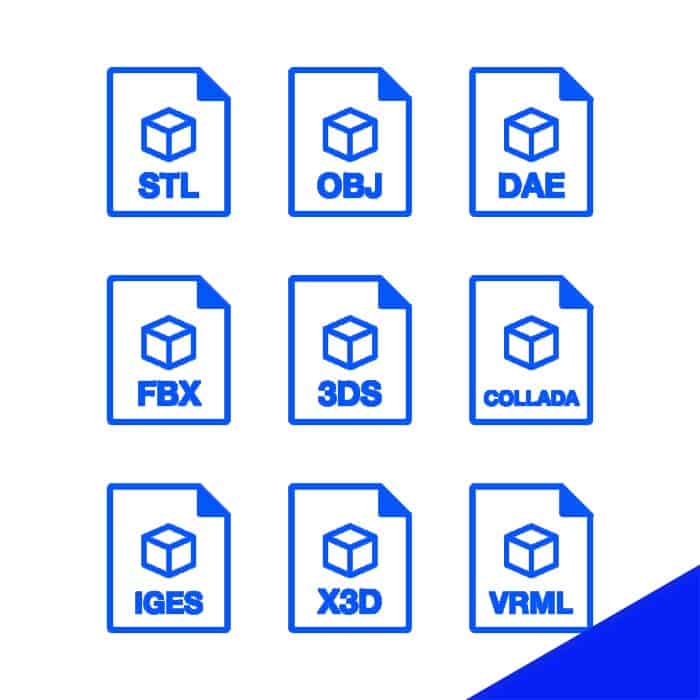In the world of 3D, there are several common file types you’ll run into. Some are proprietary and limited to a single 3D software. Others are more universal and can be used to transfer 3D models from one program to another.
Whether you’re a 3D artist, animator or are 3D printing, this list of common 3D file types should explain what they’re used for and the differences between them.
This page may contain affiliate links which pay me a commission if used to make a purchase. As an Amazon Associate, I earn from qualifying purchases.
Most Common 3D File Types
Here’s a list of the common 3D file types I’ve encountered. I admit I haven’t used all of them, but have tried to explain what each one is used for.
FBX (Filmbox) File
Developed by Autodesk, FBX is a versatile file format used for exchanging 3D models, animations, and other assets between different software applications. It supports geometry, materials, textures, animations, and more. FBX is widely used in the gaming and entertainment industries.
This is my preferred method of transferring 3D files between programs. But, I’ve noticed GLTF is more commonly being supported and when it is, I use it instead.

OBJ (Wavefront Object) File
OBJ is a popular open standard file format that stores 3D geometry information, including vertices, faces, and texture coordinates. It does not support animations or advanced materials, but it is widely supported by various 3D modeling and rendering software. OBJ files are often used for sharing 3D models.
STL (Stereolithography) File
Originally developed for 3D printing, STL is a file format that represents a 3D object as a collection of triangular facets. It only contains geometry information and does not support color, textures, or animations. STL files are commonly used for rapid prototyping and additive manufacturing processes.
.Blend (Blender 3D) File
.Blend is the native file format used by Blender, a popular (and my favorite) open-source 3D modeling and animation software. It stores a wide range of data, including geometry, materials, textures, animations, and more. .Blend files are (almost entirely) used inside of Blender.
By the way… Yes, Blender is completely free! And it doesn’t suck!
DAE (Collada) File
Collada is an XML-based file format designed for exchanging 3D assets between various software applications. It supports geometry, materials, animations, cameras, lights, and other elements. Collada files are often used for interoperability and are supported by many 3D software packages.
GLTF (GL Transmission Format) File
GLTF is becoming a more popular format for sharing 3D models on the web. It’s an open standard file format designed for efficient transmission and loading of 3D scenes and models.
It supports geometry, materials, textures, animations, and other scene-related data. GLTF is gaining popularity due to its small file size, compatibility with web applications, and support for PBR (Physically-Based Rendering) materials.
3DS (3DS Max) File
3DS is a legacy binary file format originally developed for Autodesk’s 3D Studio software. It stores geometry, materials, textures, and animations. While it is still supported by some software applications, it has been largely replaced by more modern formats like FBX or OBJ.

PLY (Stanford Polygon File Format)
Also known as the “Stanford” format, PLY is a flexible file format commonly used for storing 3D scan data or point clouds. The format was developed by the Stanford Computer Graphics Laboratory in the 1990s. It supports both geometry and color information, making it suitable for capturing real-world objects.
PLY files can also store additional data such as normals, texture coordinates, and custom attributes.
DXF (Drawing Exchange Format) File
DXF is a file format developed by Autodesk for 2D and 3D CAD (Computer-Aided Design) data exchange. It is widely supported by CAD software and can store geometry, layers, annotations, and other relevant information. While primarily used for 2D designs, DXF can also represent 3D objects. As a Blender user, I’ve never come across this format.
STEP (Standard for Exchange of Product Data) File
STEP is an ISO standard file format used for the exchange of product data, including 3D models. It is apparently used in the manufacturing industry for sharing complex CAD models along with metadata.
STEP files can contain geometric and topological information, as well as assembly structures and product attributes. I’ve never used it.
I hope that whatever you were looking for, you found on this list. My site is dedicated to 3D education (especially with Blender). Take a look around and if you’re a Blender user, check out my YouTube channel for unique and straight-forward tutorials. Stay creative!

